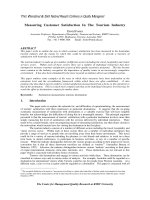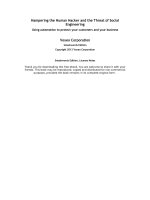captive audience the telecom industry and monopoly power
Bạn đang xem bản rút gọn của tài liệu. Xem và tải ngay bản đầy đủ của tài liệu tại đây (2.36 MB, 552 trang )
Copyright © 2013 by Susan Crawford.
All rights reserved.
This book may not be reproduced, in whole or in part, including illustrations, in any form (beyond
that copying permitted by Sections 107 and 108 of the U.S. Copyright Law and except by reviewers
for the public press), without written permission from the publishers.
Yale University Press books may be purchased in quantity for educational, business, or promotional
use. For information, please e-mail (U.S. office) or
(U.K. office).
Set in Scala type by IDS Infotech, Ltd.
Printed in the United States of America.
Library of Congress Cataloging-in-Publication Data
Crawford, Susan P., 1963–
Captive audience: the telecom industry and monopoly power in the new gilded age / Susan Crawford.
p. cm.
Includes bibliographical references and index.
ISBN 978-0-300-15313-2
1. Telecommunication—Law and legislation—United States.
2. Antitrust law—United States. I. Title.
KF2765.C73 2013
384.0973—dc23
2012024367
A catalogue record for this book is available from the British Library.
This paper meets the requirements of ANSI/NISO Z39.48–1992
(Permanence of Paper).
10 9 8 7 6 5 4 3 2 1
To the next generation
CONTENTS
Introduction
1 From Railroad to Telephone
2 Regulatory Pendulum: The Long Twilight Struggle
3 A Family Company
4 Going Vertical: Lessons from AOL–Time Warner
5 Netflix, Dead or Alive
6 The Peacock Disappears
7 The Programming Battering Ram
8 When Cable Met Wireless
9 The Biggest Squeeze of All
10 Comcast's Marathon
11 The FCC Approves
12 Aftermath
13 The AT&T–T-Mobile Deal
14 The Costly Gift
Notes
Acknowledgments
Index
Introduction
ON A GRAY DAY IN FEBRUARY 2010 , Brian Roberts sat facing the Senate Judiciary
Committee's Antitrust Subcommittee. The subcommittee was holding its
first hearing on a proposed merger between two of the country's most
powerful media companies, the cable distribution giant Comcast and the
entertainment conglomerate NBC Universal (NBCU). Roberts, the chief
executive officer of Comcast, was a calm and friendly witness that day,
as he testified before the branch of government that had created the
antitrust laws in the first place. If the merger were approved by the
Justice Department's Antitrust Division and the Federal Communications
Commission, Comcast's future as the largest vertically integrated
distributor of information in the country would be assured. 1
Big mergers happen all the time in America. The importance of this
one lay in the fact that Comcast was gaining strength as a monopoly
provider of wired high-speed Internet access in the areas it served, while
America was lagging far behind other countries when it came to the
prices charged for and the speed and capability of this basic
communications tool. At the same time, the Internet was becoming the
common global medium, with a unique capacity to empower individuals,
groups, businesses, and governments around the world collectively to
change their economic, political, and social fates. With high-speed
Internet access, a farmer in Missouri can instantly access weather
conditions and crop prices while his high school children get a world-
class education; Native Americans on a remote reservation can have their
eyes checked by a distant doctor and avoid the blindness associated with
diabetes; entrepreneurs and small businesses in California, New York,
and all the states in between can find inexpensive entry points into global
markets. Communities can plan their own destinies.
A decade earlier, the United States had led the world in adoption of
Internet access. By the time of the hearing, America had fallen behind
most other industrialized nations:2 customers in rural and poorer areas
were getting spotty service, while those in wealthier areas were paying
much more for high-speed access than their counterparts in other
countries. In most of Comcast's market territories, it was the only high-
speed access provider selling services at speeds that would be sufficient
to satisfy Americans’ requirements in the near future. But the access
Comcast sold was less useful than it could have been because the network
had been designed to be contested among users in the same neighborhood
(making speeds unreliable) and favored passive consuming uses
(downloads) far more than active uploads. Meanwhile, the service that all
Americans would need within five years (truly high-speed Internet access
ranging from 100 Mbps, or megabits per second, to gigabit speeds over
fiber-optic lines), the service that would allow symmetrical (same-speed)
uploads and downloads and extensive use of online streaming video for a
host of educational, medical, and economic purposes, was routinely
available in other countries but could not be purchased at all in most parts
of the United States. 3 Through the merger, Comcast would become even
more entrenched and powerful, with unconstrained ability to set prices
and conditions for wired Internet access in the areas of the country it
served. America would never catch up to the rest of the world if Comcast
and its fellow cable distributors controlled truly high-speed wired
Internet access.
Because the merger would allow Comcast to more effectively control
key sports and other content that many Americans prized, Comcast's new
amplified role as a programmer—taken together with its ability to
coordinate with its programming brethren—would probably make content
too expensive for any potential competing data distributor. Any new
high-speed Internet access provider in Comcast territory would have to
enter the market for content at the same time it incurred the heavy up-
front costs needed to provide wired Internet access. Entering two markets
at once is extremely difficult. Competition would be unlikely, leaving
Americans in Comcast's territories reliant on Comcast alone for truly
high-speed wired Internet access. Indeed, by the time the Comcast-NBCU
merger was announced at the end of 2009, 4 Verizon, the only nationwide
company installing globally competitive truly high-speed access across
fiber-optic lines in America, had already signaled that it was planning to
stop doing so. 5 It was just too hard to compete with Comcast.
In turn, Comcast had no incentive to make the Internet access it did
sell affordable, globally competitive in terms of its capabilities, or
available to everyone within its territories. Nor did it have any incentive
to upgrade the networks it had built to fiber optics; the company was
ready to reap the rewards of dominance. 6 Truly high-speed wired Internet
access is as basic to innovation, economic growth, social communication,
and the country's competitiveness as electricity was a century ago, but a
limited number of Americans have access to it, many can't afford it, and
the country has handed control of it over to Comcast and a few other
companies.
It gets worse. Think of Comcast as an operator of a giant waterworks,
with a connection to each home in the communities it serves. Some of the
“water” it delivers is made up of traditional digital cable channels, and
some of it is Internet access. But all of it is data flowing down a single
conduit: Comcast's business is carrying digital communications through a
wire. A water carrier does not own the water itself. In this merger,
however, Comcast was seeking to own the content it provided. This set up
a huge conflict of interest: even as the Internet was becoming the world's
general-purpose network, the merger would put Comcast in a prime
position to be the unchallenged provider of everything—all data, all
information, all entertainment—flowing over the wires in its market
areas. The company would have every incentive to squeeze online
services that were unwilling to pay the freight to Comcast. The future of
the Internet itself in America as well as the terms on which Americans
would be able to buy wired Internet access would be radically affected by
the merger decision.
Although approval of the merger was technically up to the Justice
Department's Antitrust Division and the Federal Communications
Commission (FCC), the Senate subcommittee was hardly irrelevant. It
represented the branch of government that oversees the budgets of the
agencies charged with implementing the antitrust laws. But there were
other reasons the subcommittee's role was important: the political
questions inherent in any major merger—Will it create or destroy jobs?
Is the merging company viewed as a good corporate citizen with a
friendly relationship with unions? Does the company have a diverse
workforce? Is the merger too big to bear?—always come to Congress as a
flurry of private meetings and one-page lists of factoids and talking
points. Congressional political pressure (or lack of it) is relevant to the
Justice Department and the FCC, even if both organizations deny that
politics has anything to do with their expert administrative merger
review. The hearing was relevant to the optics of the deal.
As Comcast's chief executive officer, chair, and president, Roberts was
the first witness. He began his testimony by talking about Comcast's
founding nearly fifty years earlier by his father, Ralph Roberts, who sat in
the front row directly behind his son, looking on with a mild smile,
decked out in a perky bow tie. With his earnest, calm demeanor, pleasant
mid-Atlantic accent, and neatly combed appearance, Brian Roberts was a
soothing presence. He wasn't flashy, loud, colorful, or arrogant—exactly
the kind of respectful, moderate CEO a company would want to put in
front of a Senate subcommittee when seeking approval for a world-
changing merger. Formal approval of the deal was still eleven months in
the future, but Brian Roberts exuded quiet confidence. 7
He had told investors in a conference call in late 2009, a few months
before the Senate hearing, that “with this transaction” Comcast was
“strategically complete.” 8 In other words, the merger would put Comcast
in a position to reap the rewards of operating on a giant scale—keeping
its costs of operation as low as possible—as well as allow it to control
desirable content so as to make it nearly impossible for a competitor to
threaten Comcast's position as the dominant U.S. data-distribution
company. After more than forty years of steady acquisitions, including
some of the largest deals in the industry, Comcast was done.
So many deals are announced in the media industry and so many shiny
new devices are regularly introduced that most Americans probably
believe that the communications sector of the economy has room for
innumerable competitors. But they might be surprised at how
concentrated the market for the modern-day equivalent of the standard
phone line is. These days what that basic transmission service is
facilitating is high-speed access to the Internet. In that market, there are
two enormous monopoly submarkets—one for wireless and one for wired
transmission. Both are dominated by two or three large companies.
On the wired side, Comcast is the communications equivalent of
Standard Oil. It is a mammoth enterprise: even before its merger with
NBC Universal, it was the country's largest cable operator, its largest
residential high-speed Internet access company, its third-largest phone
company, the owner of many key cable content properties—including
eleven regional sports networks—and the manager of a robust Video on
Demand platform. Comcast's high-speed Internet access services, bought
by nearly 16 million Americans, were flourishing, throwing off more than
$2 billion a quarter. (In contrast, the second-largest high-speed Internet
access services provider via cable, Time Warner, had about 9 million
customers.) Comcast dominated many local markets in major U.S. cities,
including Philadelphia, Chicago, San Francisco, Seattle, and Boston.
Now it was seeking to buy NBC Universal, a content conglomerate that
owned some of the most popular cable networks in the country and one of
the largest broadcast networks, with twenty-five television stations, seven
production studios, and several key Internet properties, including iVillage
and a one-third interest in Hulu.com. NBC Sports had broadcast more
Olympics than any other network and had televised sixteen Super Bowls.
Wimbledon, the French Open, the Stanley Cup final, Sunday Night
Football, the U.S. Open, and the Kentucky Derby were all NBC Sports
properties. Two giant entities, one devoted to distribution of content and
the other to programming, were joining forces. Together they would be a
media and entertainment colossus with sweeping power to decide what
Americans watched and read. The merged company would control one in
five hours of all television viewing in the United States, would own more
than 125 media outlets (cable channels, television stations, film studios,
Web sites), and, most important, could use that control over content to
dominate the market for high-speed wired Internet access in most of the
country's major cities. 9
Other players had taken their places that day in that hearing room or
were represented by their proxies. The senators on the committee sat on
raised platforms behind microphone stands, their staffers pressed against
the wall behind them ready to hand a note or listen to a whispered
question. Witnesses were arrayed facing the senators behind a plain
wooden table: Jeff Zucker, the head of NBC Universal, who had come
under harsh criticism for his management of the NBC TV broadcast
network, was seated to Brian Roberts's left.
NBC-the-network was almost lost in the rounding when it came to
NBC Universal's overall success as a media conglomerate; even as the
network continued to lose money, Comcast could leverage NBCU's
powerful cable channels—like USA and Bravo—as a means of keeping
competition from rival distributors at bay. Comcast had used the
enormous profits from its pay-TV services to subsidize the construction
of the nation's most subscribed-to wired high-speed Internet access
service, but without reasonably priced access to key programming no one
would be able to follow suit.
On Zucker's left, the other cable companies were represented by a
token competitor, Colleen Abdoulah, president and CEO of WOW!
(WideOpenWest Networks). A midsized cable system struggling to
compete for subscribers in Comcast's territory in the Midwest, WOW!
was trying to win over consumers by providing better customer service,
but it was forced to pay high prices for take-it-or-leave-it bundles of
programming owned by NBC Universal and other media conglomerates.
The big cable-distribution companies like Comcast can get those bundles
for far less than the smaller companies. Abdoulah would testify that if
Comcast controlled NBC Universal, negotiations for the programming
WOW! needed to retain subscribers were likely to become even more
one-sided. Two public-interest advocates, Mark Cooper (instantly
recognizable with his thick glasses and emphatic delivery) and Andy
Schwartzman (white bushy eyebrows and a thick moustache), both
veterans of decades-long tussles with the cable industry, were seated to
her left.
Behind the witness table, several rows of professional Washington sat
quietly facing the senators. In the first row, visible behind Brian Roberts
from the senators’ perspective, and next to nearly ninety-year-old Ralph
Roberts, was David Cohen, the political genius pulling the strings on
behalf of Comcast. Long before this hearing, Cohen had used his
energetic mastery of national politics and his formidable Democratic
credentials to shape the all-important narrative of the merger, the simple
political story that would be patiently, ceaselessly repeated until no other
story seemed credible: Comcast, a true-blue American success story of a
family company, was merging with NBC Universal in order to save the
NBC broadcast network and bring order as well as technical innovation to
the cable-TV industry. Cohen's strategic genius had molded the narrative
in response to his assessment of the political situation in Washington, and
he had probably already planned the next several steps following the
proceedings.
Cohen was no slouch as an antitrust lawyer either. For anyone willing
to engage them on the substance of the deal, Cohen and his team were
ready with smooth responses. From their perspective, the deal was a
vertical combination of a distributor and a programming company, not a
horizontal combination that would result in fewer competing distributors,
and thus it was not the kind of transaction with which antitrust law should
be concerned. In a year-long process of ticking boxes and being
respectful of various political offices and regulatory niche inhabitants,
Cohen and his team would meet with all individuals, companies, and
agencies that seemed relevant and explain why the Comcast merger
aligned precisely with their interests. The Comcast team would show
interest and professional engagement with the various conditions that the
regulators required in order to clear the merger, as long as those
conditions did not interfere with the company's business plans. 10
Behind the witnesses sat representatives of other media and
telecommunications companies, well-groomed, mostly male, and placidly
enjoying this rare public ritual. (Major hearings don't happen every week
in the telecommunications field.) There is a constant, easy, friendly flow
between government and industry in the communications world bounded
by the suburbs of Arlington, Virginia, and Bethesda, Maryland.
Regulators switch jobs and become the regulated; the regulated leave
their posts and take leadership roles in trade associations; everyone stays
in touch. This crowd was easy to like; they were well-intentioned,
engaging, and undogmatic, with a light touch and a smattering of
technical know-how.
Despite the bonhomie of the hearing room, the merger represented a
new, frightening moment in U.S. regulatory history. If a few large
companies were to get control over electricity or clean water in America
in particular geographic regions and could decide without oversight who
would have access to it and what kinds of uses they could make of it, at
what cost, there would be a public uproar. Instead of electrical utilities or
water companies, the entities involved were media conglomerates:
Comcast, the dominant distributor of communications in twenty-two of
America's twenty-five largest cities, 11 was seeking to buy one of the five
media powerhouses that furnished more than 80 percent of America's
primetime entertainment and news. 12 Instead of electricity or water,
Comcast was gaining dominion over the country's latest utility
infrastructure: high-speed Internet access. Simultaneously, rather than
install twenty-first-century fiber-optic lines to replace the metal wires
that had brought all Americans telephone service, AT&T and Verizon, the
giant private telephone companies that had ceded the market for wired
high-speed Internet access to the cable companies, were working hard to
persuade states that they should be released from any obligation to
provide all Americans with telephone service where it was not in line
with their business plans. By mid-2012, four states had already removed
this requirement, and six others were poised to do so. 13 Americans would
be left with a grotesquely skewed communications-utility picture: the
rich would pay whatever the cable companies chose to charge for wired
Internet access while poor and rural Americans would be relegated to
expensive, second-best wireless connections. At the same time, much of
the rest of the developed world was racing to install first-best standard
fiber connections to their citizens.
Seen from the outside, the Comcast-NBCU deal seemed like a typical
big-box media merger. And in some ways it was: the consolidation of
market power, deregulation, and tearing of the social fabric in the
communications-utility sector had been going on for decades. Opponents
of the deal were shooting at a subtarget, in a sense. They argued that
media consolidation had reached a saturation point and that the Comcast-
NBCU merger would lead to homogenized entertainment sold for high
prices by extraordinarily profitable giant companies. Americans would
have almost unlimited freedom to watch a dazzling variety of football
games, cooking shows, and other forms of entertainment coming from a
very small number of sources. Although that was all true, the overarching
problem came from control over pipes: with this acquisition Comcast
would have even more power in its market areas to dictate the terms on
which access to all kinds of information—entertainment, news, sports,
data, phone conversations—could be had.
The deal's supporters (chiefly Comcast itself) had only to respond that
the merger would not make the situation for consumers worse than it
already was. If opponents could not decisively prove “merger-specific
harms,” the phrase Comcast employees repeated endlessly to staffers
across Washington, the deal could not be blocked. If there were problems
of concentration in the cable-distribution marketplace, they had existed
before the merger was announced and could be taken up at a later date.
Whether that date would ever arrive was unclear.
By February 2010, the accepted wisdom in Washington was that the
deal would go through. No major company had opposed it publicly, and
without an influential corporate entity on the other side to give politicians
cover, there was little advantage to fighting the merger. No one wanted to
appear unfriendly to business during the dark days of the U.S. recession.
Besides, there was some appeal to the vertical argument. If the
Department of Justice in a Democratic administration tried to block the
merger, it might be pummeled by a conservative reviewing court—there
are more Republicans than Democrats on the circuit appeals courts and
on the federal bench as a whole—after a protracted litigation battle
against one of the deepest-pocketed businesses in America.
But the deal showed Americans their Internet future. Even though there
are several large cable companies nationwide, each dominates its own
region. The major cable companies never compete with one another
because each wants to reap the advantages of scale that come with control
over entire markets. Because no other widely available privately provided
wired Internet access product is fast enough or can be installed cheaply
enough to compete with cable, each of the country's large cable
distributors can raise prices in its region for high-speed Internet access
without fear of being undercut.
Wireless access, dominated by AT&T and Verizon, is too slow to
compete with the cable industry's offerings; mobile wireless services are
complementary to the wired access Comcast sells. Verizon Wireless's
joint marketing agreement with Comcast, announced in December 2011, 14
made that truth visible: fierce competitors don't offer to sell each other's
products. In a nutshell, the giant companies that dominate high-speed
Internet access in America have tacitly divided up the marketplace.
AT&T and Verizon are devoting themselves to wireless access, where
they are by far the two largest players, rather than competing head to
head with Comcast for truly high-speed wired Internet access, and they
would do almost anything to shed themselves of their traditional
obligation to provide wired access to all Americans. Comcast and Time
Warner Cable are concentrating on wired access and reaping profit
margins of about 95 percent for the service. 15 And consumers are paying
more in the United States than people in other countries do—for less
speedy service—as inequality between the haves and have-nots is
amplified by the digital divide.
It doesn't have to be this way. Other developed countries have a
watchdog to ensure that all their citizens are connected at cheap rates to
the fastest possible open-access ramps (that is, fiber-optic access) to the
Internet. In South Korea, more than half the households are already
connected to fiber lines that allow for blazing-fast uploads and
downloads, and households in Japan and Hong Kong are close behind. 16 In
America, only around 7 percent of households have access to fiber, and
the service costs six times as much as it does in Hong Kong (and five
times as much as it does in Stockholm). 17 Vertically integrated cable
companies, whose Internet access product is not provided over fiber and
crimps uploads, are well on the way to controlling America's Internet
access destiny, having spent millions of dollars over almost fifteen years
lobbying against any rules that might have constrained them.
Instead of ensuring that everyone in America can compete in a global
economy, instead of narrowing the divide between rich and poor, instead
of supporting competitive free markets for American inventions that use
information—instead, that is, of ensuring that America will lead the
world in the information age—U.S. politicians have chosen to keep
Comcast and its fellow giants happy. The government removed all rules
from high-speed Internet access and allowed steep market consolidation
in the hope that competition among providers would protect consumers.
But that competition has not materialized; the cable industry, whose
collusive practices have been largely ignored by regulators, has
decisively dominated the wired marketplace and has done its best to foil
municipal efforts to provide publicly owned fiber Internet access. 18 As a
result, the United States now has neither a competitive market for high-
speed wired Internet access nor government oversight.
The giant communications companies unite in claiming that the
situation is under control. In response to an op-ed of mine published by
t h e New York Times in December 2011, Ivan Seidenberg, CEO of
Verizon, wrote, “America has a very good broadband story; someone just
has to be willing to tell it.” These companies claim that regulation will
stifle investment and innovation. This kind of argument is not new. When
Brooksley Born, chair of the Commodity Futures Trading Commission
(the federal agency which oversees the futures and commodity options
markets), suggested during the Clinton administration that derivative
financial products should be overseen by regulators, she was immediately
met by a firm, flattening political response: interfere with the financial
sector, and you will destroy innovation and investment. 19 Several years
ago, many people made fun of Al Gore for saying that climate change
was endangering our future; his critics insisted that the data he was
pointing to represented no more than normal fluctuations magnified by
over-anxious minds. To regulate carbon emissions would destroy
innovation and investment.
As a policy issue, the crisis in American communications bears some
similarity to the banking crisis and global warming: it has taken decades
to arrive; it has happened through incremental policy decisions, mergers,
and changes in society; it involves technical terms that enable easy
obfuscation; large entities have an interest in maintaining the status quo;
and there is a great deal of political bluster about the possible effect of
regulation on innovation and investment. In the communications industry
no signal crisis—no equivalent of the banking collapse—has erupted to
trigger public outrage. Reporters usually don't cover regulatory
proceedings because they are slow moving and impenetrable. As a result,
the players involved, who know exactly what's going on and why it's
important, can get away with dazzling political sleight-of-hand. “Look,
there, a new gizmo!” they say to their customers, believing (accurately
enough) that few of them will put the pieces together and figure out the
truth about the grinding monopolistic power and lack of social contract
that underlies the American communications industry today.
This issue hits consumers’ pocketbooks at the same time that it
implicates national industrial policies. When the telephone was the
dominant medium of exchange, U.S. law required that every American
have access to a phone along with other utility services such as water and
electricity. Although the Internet has become the common medium of our
era, and no one can get a job or apply for benefits or keep up with the rest
of the world without high-speed access, this service is framed as an
expensive luxury reserved for the rich; fully a third of Americans don't
subscribe to high-speed Internet access, and nonsubscription is highly
correlated with low socioeconomic status. 20 This situation has arisen
because Americans have allowed the companies involved to cherry-pick
wealthy neighborhoods for service and charge whatever they like. Now
states, heavily lobbied by telecommunications companies, are seeking to
get rid of any obligation to provide communications services to all their
citizens. None of this was inevitable; all of it is bad for individual
consumers.
Americans are suffering as a result; it is already clear that unless
something is done the next disruptive Internet innovation, the new
breakthrough invention that depends on the existence of an experimental
sandbox of millions of users with fiber high-speed Internet access, will
not come from America. The country does not have the critical mass of
people connected to fiber that other countries do; instead, those American
consumers who can are (over)paying for privately provided, pinched-
upload cable services. Symmetrical and highly reliable connections are
especially important for businesses, which typically make even heavier
use of upstream paths than households. So the much-needed economic
boost that comes from creating and marketing the next big thing will go
elsewhere. But few people with the power to change the situation seem to
understand this.
This book tells the story of the forces that made the Comcast-NBCU
merger possible. Three paradigm shifts happened between 1996 and 2010
that shaped the narrative. First, the big new idea behind the Internet was
that its language—and language is all the Internet is, a couple of simple
agreements that allow computers to “speak Internet”—facilitated a
general-purpose global open network of networks that has changed two
billion lives around the world while becoming the single common digital
platform for communication. Second, the cable and telephone companies
across whose wires Internet talk was flowing made a successful concerted
effort to persuade the FCC to completely deregulate provision of the two-
way, general-purpose communication on which the country's economic,
cultural, political, and social life depends: high-speed Internet access.
This meant that the success of the cheerfully disruptive activities
happening online became entirely contingent on the generosity of the few
large companies selling access. And third, newly elected president Barack
Obama seemed to understand that high-speed access to the Internet was
essential for anyone wanting to participate effectively in the twenty-first-
century global economy. He suggested that nondiscriminatory, ubiquitous
connections were essential—or he seemed to. It looked as if government
intervention to ensure world-leading, reasonably priced, wired open
Internet access for everyone would be an important priority for the new
administration.
Things did not turn out that way, for a range of reasons that I hope to
make clear in this book, and the consequences of this failure in policy are
likely to be a drag on America's success for generations.
The February 2010 Senate Antitrust Subcommittee hearing turned out
to be a well-produced piece of political theater. It provided a public
opportunity for selected opponents of the merger to warn about the risks
to communication and culture posed by the merger of Comcast and NBC
Universal. But David Cohen had done his work well. All the senators had
been visited by well-primed representatives of the merging companies,
all the facts had been shaped by messaging experts—this merger is about
saving the NBC Peacock!—and nothing would change as a result of any
word spoken that morning. Roberts himself was appropriately deferential
and polite.
As the hearing wound on, Roberts's calm bearing contrasted sharply
with that of consumer advocates Schwartzman and Cooper, who looked
comparatively unkempt and sounded far from calm, their voices strained
with angry passion as they spoke against the merger. Schwartzman and
Cooper understood what was at stake and did their best to explain the
threat the merger represented. But they were up against a well-funded,
decades-long campaign by the companies involved to free themselves
from government review. The two men were there to speak their part on a
stage that had been set long before they arrived.
Roberts never faltered during the hearing, and his performance was
judged a success by the trade press articles that appeared the following
day. The Wall Street Journal reported just a few months later that he was
already shopping for a multimillion-dollar apartment in New York City
within walking distance of the home of the future joint venture, even
though the deal would not be formally approved for another eight
months. 21 (The head of the merger effort within Comcast, Stephen Burke,
later paid almost $17 million for his new New York City home.) 22
Comcast's wealth was no secret: according to Bernstein Research, a
media analysis firm, the company was soaking up “torrents of cash” in
2010. 23 Its profits were up in the middle of a recession, its dividends and









